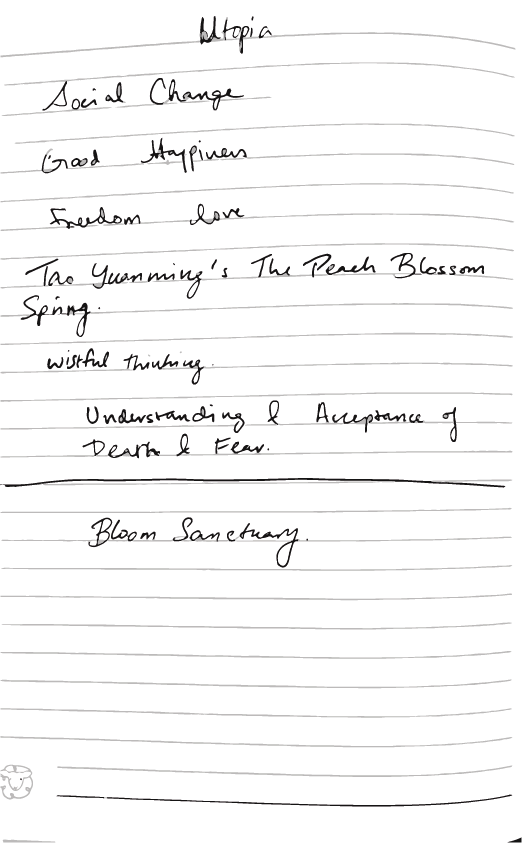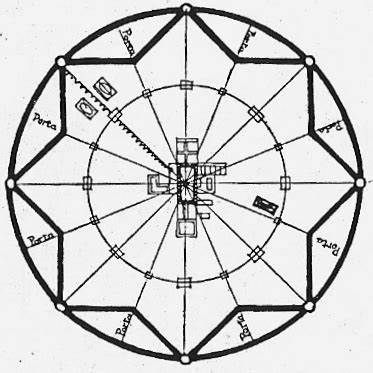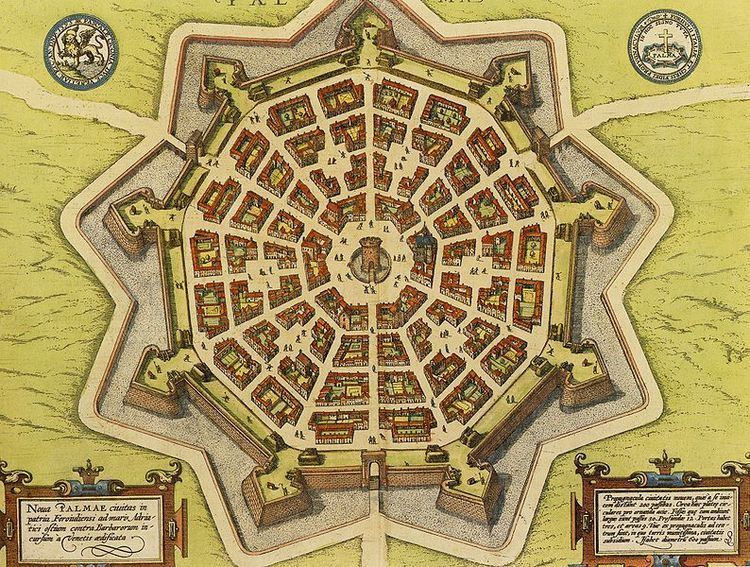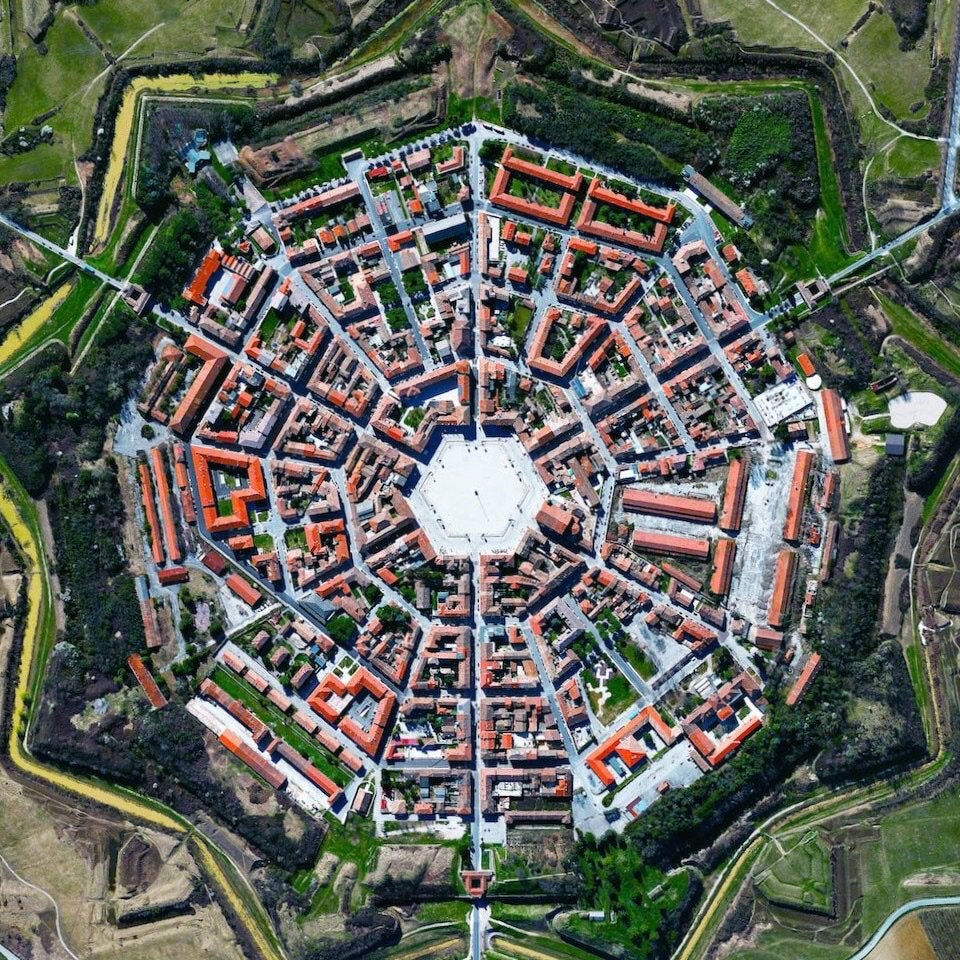Theoretical Utopias
- Crystal J Ann

- Apr 6, 2022
- 4 min read

I was looking at more Utopias, theoretical and mythical ones alike. I was having a lot of trouble understanding how to create a Utopia because I was stuck on making it sustainable and practical. So I tried to look at more thought based ideas, imagination gave the utopias the capacity even more fanciful and radical.
Sforzinda
The Renaissance was when the first notions of "city planning" emerged. Rather than allowing it to grow and develop naturally over time, they took to designing a city. Sforzinda was one of the first ideal cities designed, in the 15th century by Antonio di Pietro Averlino.

The most famous part of Filarete's Trattato di architettura is his plan for Sforzinda, his ideal city. Sforzinda was named after Francesco Sforza, the Duke of Milan, and was never built. However, its plan designs were described in great detail. The basic layout of the city was an eight-point star, created by overlaying two squares so that all the corners were equidistant. This shape was then inscribed within a perfect circular moat. This shape is iconographic and probably tied to Filarete’s interest in magic and astrology. Consistent with Quattrocento or fifteenth-century notions concerning the talismanic power of geometry and the crucial importance of astrology, Filarete provides, in addition to pragmatic advice on materials, construction, and fortifications, notes on how to propitiate celestial harmony within Sforzinda.

This design was a large departure from the crowded Medieval cities that had dominated Italy previously. Leonardo Da Vinci studied the designs for this city, which was never built when developing his own take on the "ideal city".
Notably, Palmanova in Italy also looks similar and is an existing utopian alike city that is a place that people can visit. This town may be a fortress, but Palmanova was also created to be a utopia by the superintendents of the Republic of Venice—a self-sustaining community where everyone was equal and had a purpose, in a city that also just happened to be a death machine. It was built in 1593 to protect the Venetian Empire from invasions by the Austrian and Turkish militaries. The fortress is a nine-pointed star with three rings expanding out from a hexagonal centre. It was a geometrically perfect city, but alas, no one wanted to live there. The Venetian Empire couldn’t lure residents into a contained city that lacked the freedom to move around and also had the very real risk of constant war and devastation. So instead, the military stayed and in 1622, a large number of pardoned prisoners moved into government-deeded properties—though it's unsure if they lived by the utopian ideals the city was founded on.

Now, the soldiers and prisoners have moved out of Palmanova, and the residents Italy tried so desperately to attract have officially entered. About 5,400 people live inside the walls. There’s a campaign going to get Unesco status applied to the city, but as of now, it's only received National Monument status from the Italian government.
Mahoroba
Mahoroba is an ancient Japanese word describing a far-off land full of bliss and peace. It is roughly comparable to the western concepts of arcadia, a place surrounded by mountains full of harmony and quiet. The origins of the word are not clear; it is described in a poem in the ancient Kojiki (Japanese chronicle of myths, legends, hymns, genealogies, oral traditions, and semi-historical accounts) as being the perfect place in Yamato (Japan).
Although there isn't much extensive literature on this particular Utopia, it features and is referenced in many Japanese TV-Shows, Anime, manga and other popular media.
Yamato wa Kuni no mahoroba Tatanazuku Aokaki-yama gomoreru Yamato shi uruwashi.
Tao Yuanming's Peach Blossom Spring
The Peach Blossom Spring was a fable written by Tao Yuanming (陶淵明) in 421 about a chance discovery of an ethereal utopia where the people led an ideal existence in harmony with nature, unaware of the outside world for centuries.

Tao Yuanming lived during a time of political instability and national disunity. The story describes how a fisherman haphazardly sailed into a stream in a forest made up entirely of blossoming peach trees, where even the ground was covered by peach petals. When he reached the end of the stream, he found a grotto. Though narrow at first, he was able to squeeze through and the passage eventually reached a hidden village.
The villagers were surprised to see him, but were kind and friendly. They explained that their ancestors escaped to this place during the civil unrest of the Qin dynasty (221–206 BC) and they themselves had not left since or had contact with anyone from the outside. As a result, they had heard nothing of subsequent changes in political regimes.

The fisherman was warmly received by the hospitable villagers and stayed for over a week. Upon leaving, he was informed that it was worthless to reveal this experience to the outside world. However, he marked his route on his way out with signs and later divulged the existence of this idyllic haven to others. They tried to find it repeatedly but in vain.
Since then, the peach blossom spring has become a popular symbol of an ideal world in the hearts of the Chinese people. The story inspired many later poems, paintings and music compositions.








https://www.kinetichealth.ca/profile/arihantgems254613/profilehttps://www.neatlittlenest.com/post/get-a-jump-start-on-your-2021-goals?commentId=e4eae793-b550-4780-a0a1-d1014a8ae23ehttps://www.imagineyounew.com/post/smooth-sculpted-arms-your-guide-to-arm-lift-surgery-and-scar-camouflage?commentId=86a02b43-9826-49a9-8121-0ef63a967635https://www.dopeasyola.com/post/dope-as-yola-lights-up-stoned-sexy-podcast-with-wiz-khalifa?commentId=ba532469-5f41-40c5-9c45-d6a3bf24dd51https://www.ameliaearhartmuseum.org/single-post/aebm-quarterly-july-2025?commentId=cd5a3041-7d87-404d-91ce-6e5ea1ac0b32